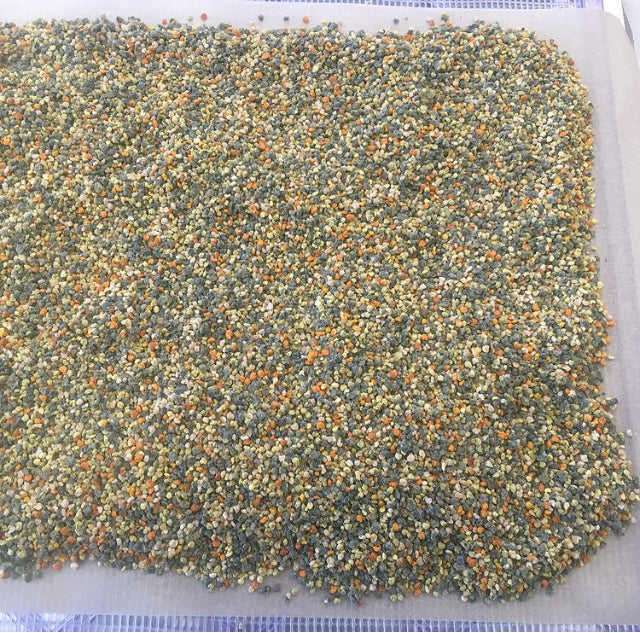
Plants have developed an amazing mutually beneficial relationship with bees. Flowers attract bees using their colors, aromas, and even sounds. The bees and other pollinators receive the reward of nectar and pollen, and the plants benefit with more seed development as the pollinators travel from flower to flower. It's a miracle of nature, and bee pollen is part of that magic!
Pollen is the only source of protein and lipids, and the main source of macro and microelements for the honey bee colony, while nectar or honeydew (processed and stored as honey) is the main source of carbohydrates (1).
All of the natural products offered by honeybees have been used since ancient times - their use as medicine is as old as beekeeping itself. Chinese texts that are over 2,000 years old mention the use of honeybee products, and Hippocrates also wrote about them (1).
Today, bee pollen is known to be a functional food. Pollen contains over 25 different micro- and macro-elements such as iron, calcium, phosphorus, potassium, copper, zinc, selenium, and magnesium. The predominant minerals in Bee Pollen were potassium, followed by phosphorus, calcium, magnesium, iron, sodium, zinc and manganese (1).
The main chemical compounds of bee pollen include carbohydrates, proteins and amino acids, lipids and fatty acids, phenolics, enzymes and coenzymes, vitamins and minerals (3). Bee pollen represents the richest and most complete natural food supplying high levels of carbohydrates (13-55%), proteins (10- 40%), particularly free aminoacids, enzymes, co- factors, lipids (1-13%), including fatty acids and sterols, minerals, trace elements and vitamins, especially B group, A, C and E (2).
Considering its nutritional value, bee pollen is primarily a source of nutritious protein. Its protein content amounts on average to 23.9% of the product dry mass. Despite the fact that the protein content in pollens of different botanical origin varies, the average protein content in pollen is similar, irrespective of the parts of the globe a particular pollen comes from (4).
Bee pollen has been used as a diet supplement in recovery periods, in cases of malnutrition, asthenia and apathy, and to increase physical and mental ability or strengthen the immune system. Experiments on animals have shown that the administration of bee pollen prolongs life span, promotes weight gain, increases plasma hemoglobin levels, and provides tissues with vitamin C and Mg. These virtues may be related to a complex of active substances, including amino acids, vitamins like tocopherol, niacin, thiamine, biotin, and folic acid, polyphenols, carotenoids, phytosterols, and minerals (3).
Modern research demonstrates many valuable healing benefits of bee pollen. Pollen's effects on improving immune, cardiovascular and digestive systems as well as their therapeutic effects have been mainly related to the polyphenol content and chemical composition. In particular, the phenolic profile of bee-pollen consists of flavonol, glycosides and aglycones, and hydroxycinnamic acids, that can be present in free forms or combined with other pollen components (2). Bee pollen constitutes a natural source of antioxidants such as phenolic acids and flavonoids, which are responsible for its biological activity (4).
Many studies concerning the properties of bee pollen indicate its anti-inflammatory properties, resulting mainly from the content of phenolic acids and flavonoids, as well as phytosterols (4). Bee pollen exerts anti-inflammatory effects that have been compared to those of common non-steroidal anti-inflammatory drugs (3).
Despite the fact that inhaled pollen may cause an allergic reaction, bee pollen in small amounts can be used for desensitization against hay fever. Recent research has indicated that bee pollen has an antiallergic activity because it protects mast cells from degranulation, and inhibits histamine release (4).
Bee Pollen is adaptogenic and can enhance mood and well-being. The adaptogenic properties of pollen, which are based on increasing the resistance to harmful physical, chemical, and biological factors, were also indicated: it increases the physical fitness of the organism in excessive physical burden, affecting the central nervous system by improving brain functions, such as memory, learning, comprehending, thinking, and ability to concentration, and increases the immune system strengths against infection. Particularly good effects are gained in depressions caused by decreased life energy, especially in older people. Long-term use of pollen, even in small doses, enables gradual mood improvement, restores the desire to live, and strengthens the organism physically (4).
This is just a small collection of what a great deal of scientific research, traditional use, and modern knowledge tells us - Bee Pollen is really good for you!
Citations:
1. Didaras NA, Karatasou K, Dimitriou TG, Amoutzias GD, Mossialos D. Antimicrobial Activity of Bee-Collected Pollen and Beebread: State of the Art and Future Perspectives. Antibiotics (Basel). 2020 Nov 14;9(11):811. doi: 10.3390/antibiotics9110811. PMID: 33202560; PMCID: PMC7697837.
2. Domenici V, Gabriele M, Parri E, Felicioli A, Sagona S, Pozzo L, et al.. Phytochemical composition and antioxidant activity of Tuscan bee pollen of different botanic origins. ITALIAN JOURNAL OF FOOD SCIENCE. 2015. Vol. 27 No. 2.
3. Cornara L, Biagi M, Xiao J, Burlando B. Therapeutic Properties of Bioactive Compounds from Different Honeybee Products. Front Pharmacol. 2017 Jun 28;8:412. doi: 10.3389/fphar.2017.00412. PMID: 28701955; PMCID: PMC5487425.
4. Rzepecka-Stojko A, Stojko J, Kurek-Górecka A, Górecki M, Kabała-Dzik A, Kubina R, Moździerz A, Buszman E. Polyphenols from Bee Pollen: Structure, Absorption, Metabolism and Biological Activity. Molecules. 2015 Dec 4;20(12):21732-49. doi: 10.3390/molecules201219800. Erratum in: Molecules. 2016;21(2):159. PMID: 26690100; PMCID: PMC6332396.
5. Komosinska-Vassev K, Olczyk P, Kaźmierczak J, Mencner L, Olczyk K. Bee pollen: chemical composition and therapeutic application. Evid Based Complement Alternat Med. 2015;2015:297425. doi: 10.1155/2015/297425. Epub 2015 Mar 11. PMID: 25861358; PMCID: PMC4377380.


